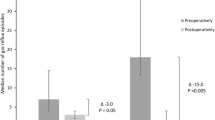Abstract
Background: The physiology of Nissen fundoplication (NF) and Toupet fundoplication (TF) is controversial. The aim of this study was to determine the contribution of elevated intragastric pressure to the antireflux mechanism after surgically created fundoplication in explanted porcine stomachs.
Methods: The stomachs and 6–8 cm of distal esophagus were removed from 15 pigs and placed in anatomic position. Five NF, 2 cm in length with three interrupted sutures, were performed, taking full-thickness bites of stomach and partial-thickness bites of esophagus around a 60 French dilator. Five 270° TF 2 cm in length with six interrupted sutures were performed taking full-thickness bites of stomach and partial-thickness bites of esophagus around a 60 French dilator. Each stomach served as its own control. The pylorus was tied off and the stomach was inflated with Ringer's lactate while the pressure was monitored.
Results: Before NF, reflux could be easily induced with a mean intragastric pressure of 5.5 ± 3.7 mmHg. After NF reflux could not be induced but the sutures pulled out of the stomach at a mean pressure of 36.8 ± 11.7 mmHg (p < 0.01 vs control). Before TF, reflux could easily be induced with a mean intragastric pressure of 3.0 ± 3.0 mmHg. After TF, reflux could not be induced and the sutures pulled out of the esophagus or stomach with a mean pressure of 30.8 ± 9.0 mmHg (p < 0.01 vs control). Porcine stomachs in vivo are resistant to reflux, but when explanted they reflux easily. NF and TF are so effective at interrupting reflux that the sutures tear out instead of allowing reflux.
Conclusions: While not yet statistically significant, it appears that sutures tear out of the esophagus (TF) more readily than they tear out of the stomach (NF). TF and NF prevent reflux in the absence of anatomic or functional components of the lower esophageal sphincter.
Similar content being viewed by others
Author information
Authors and Affiliations
Rights and permissions
About this article
Cite this article
Richardson, W., Trus, T., Thompson, S. et al. Nissen and Toupet fundoplications effectively inhibit gastroesophageal reflux irrespective of natural anatomy and function. Surg Endosc 11, 261–263 (1997). https://doi.org/10.1007/s004649900339
Published:
Issue Date:
DOI: https://doi.org/10.1007/s004649900339




